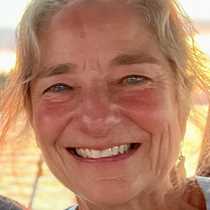Idaho Inlet and Icy Strait
We left boot tracks on the beach, creek and trails of Fox Creek, but they won’t remain for long. Soon the residents will erase them with impressions of their own paws and claws and scaly feet. There were deer tracks on the beach, eagle footprints next to the creek. As we cast shadows on the stream, the pink salmon schooled in tight formation. Soon they’ll spawn and die, just as generations have before them. Bears catch some of these returning fish; there were carcasses of partially eaten salmon on the sides of the creek. One bear had bitten open the top of a salmon’s head to eat the rich brains. Just inside the forest, red squirrels used fallen trees as little highways. A mink had left footprints in the mud of a tiny forest creek.
Many generations of brown bears have used this section of forest. We found their scratching trees. Six to eight feet high on some trees the bark was scraped off, and sticky sap trickled down. Bits of fur stuck to the bark and sap where they’d left their scent. Elsewhere there were bear tracks in soft mud. The most magical tracks of all were the bear prints that were deep depressions in the soft, green forest floor. Generations of brown bears had stepped in precisely the same footprints, time after time, year after year. Right next to these footsteps, tiny plants were untrampled. At one end of the row of footprints is a patch of skunk cabbage, where the bears dig for roots, and at the other end are two scratching trees.
We heard something melancholy and mysterious, a whining sound from some forest animal. We listened and tried to see find the source of the sound, but never could.
Some of us kayaked around a small island, and as we poked along the shoreline, we looked down at 24-armed sunflower stars and tiny, transparent jellies. A harbor seal swam near us, and miles away, a humpback whale exhaled, and the sound echoed off mountains and seemed to get louder as it traveled across glassy calm, quiet waters.
As we traveled east in Icy Strait, there were harbor porpoises and strong current lines. Many of us had napped after lunch, and when we arrived at Point Adolphus, humpback whales were napping too. Four whales were moving slowly, resting. Three other humpbacks rested at the surface a few hundred yards away. Eventually the two groups joined up. The seven whales slowly swam in one direction, then turned around and swam back. A couple of times came they swam very close to Sea Lion. As they breathed, there were seven loud breaths, and fifteen-foot tall ‘smokestacks’ of water vapor.
We left boot tracks on the beach, creek and trails of Fox Creek, but they won’t remain for long. Soon the residents will erase them with impressions of their own paws and claws and scaly feet. There were deer tracks on the beach, eagle footprints next to the creek. As we cast shadows on the stream, the pink salmon schooled in tight formation. Soon they’ll spawn and die, just as generations have before them. Bears catch some of these returning fish; there were carcasses of partially eaten salmon on the sides of the creek. One bear had bitten open the top of a salmon’s head to eat the rich brains. Just inside the forest, red squirrels used fallen trees as little highways. A mink had left footprints in the mud of a tiny forest creek.
Many generations of brown bears have used this section of forest. We found their scratching trees. Six to eight feet high on some trees the bark was scraped off, and sticky sap trickled down. Bits of fur stuck to the bark and sap where they’d left their scent. Elsewhere there were bear tracks in soft mud. The most magical tracks of all were the bear prints that were deep depressions in the soft, green forest floor. Generations of brown bears had stepped in precisely the same footprints, time after time, year after year. Right next to these footsteps, tiny plants were untrampled. At one end of the row of footprints is a patch of skunk cabbage, where the bears dig for roots, and at the other end are two scratching trees.
We heard something melancholy and mysterious, a whining sound from some forest animal. We listened and tried to see find the source of the sound, but never could.
Some of us kayaked around a small island, and as we poked along the shoreline, we looked down at 24-armed sunflower stars and tiny, transparent jellies. A harbor seal swam near us, and miles away, a humpback whale exhaled, and the sound echoed off mountains and seemed to get louder as it traveled across glassy calm, quiet waters.
As we traveled east in Icy Strait, there were harbor porpoises and strong current lines. Many of us had napped after lunch, and when we arrived at Point Adolphus, humpback whales were napping too. Four whales were moving slowly, resting. Three other humpbacks rested at the surface a few hundred yards away. Eventually the two groups joined up. The seven whales slowly swam in one direction, then turned around and swam back. A couple of times came they swam very close to Sea Lion. As they breathed, there were seven loud breaths, and fifteen-foot tall ‘smokestacks’ of water vapor.




